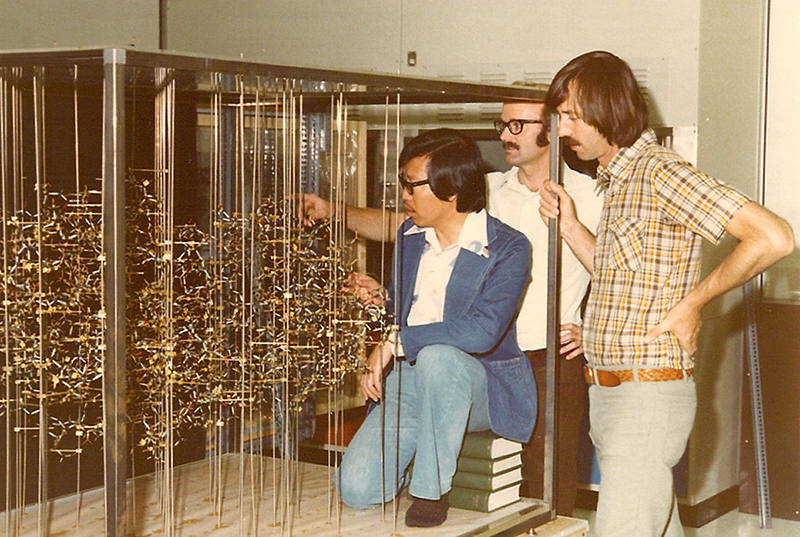
I-Nan Hsu, Louis Delbaere and Michael James examining the newly-constructed model of Penicillopepsin University of Alberta, 1977 (Photos by Graheme Williams and Gary Brayer).
On June 15, 2017, the Faculty of Medicine & Dentistry's Department of Biochemistry salutes Michael James and his outstanding research career spanning 50 years. In 1968, James established at the University of Alberta the first laboratory in Canada dedicated to the study of proteins by crystallography, a technique used to determine the structure of a protein in order to understand how it functions.
James' many scientific breakthroughs had a great impact on the development of anti-viral HIV drugs and his work has led to the development of drugs to control high blood pressure. His current research on critical enzyme structures will lead to a greater understanding of the treatment of rare genetic diseases.
"Dr. James is one of our giants―the father of protein crystallography in Canada," said dean Richard Fedorak. "He has set the bar high for our U of A researchers to follow in his footsteps and take his scientific contributions to greater lengths."
James trained at Oxford with Dorothy Mary Crowfoot Hodgkin, who won the Nobel Prize in Chemistry in 1964 for her work in protein crystallography. After earning his PhD in 1966 and holding a National Research Council postdoctoral fellowship at the U of A in the Department of Chemistry, he was recruited to the Department of Biochemistry by Cyril Kay and Larry Smillie. He was a member of the pioneering Medical Research Council group in protein structure and function from its formation in 1974.
"Michael solved some major structures and essentially trained most protein crystallographers in Canada and many internationally. These are not small accomplishments," reflected Cyril Kay. "He is a great comrade and devoted to people he is close to, as well as a superb teacher."
Here are some of the scientific firsts Michael James is responsible for over the course of his 50-year career working at the forefront of biochemistry and structural biology:

1976: First 3D structure of an aspartic protease. The structure of penicillopepsin is determined in James' lab by I-Nan Hsu and Louis Delbaere in collaboration with Theo Hofmann at the University of Toronto. This work forms the basis for future research on renin, pepsin, and the retroviral aspartic peptidase, HIV protease, an enzyme that is critical for the replication and life cycle of the HIV virus.
1985: First 3D structure of Troponin C (TnC), the calcium-binding protein in muscle, and the first atomic resolution of any muscle contraction protein. James determines the structure of TnC in collaboration with Larry Smillie who determined its sequence, and Cyril Kay who determined its size and shape.
The U of A's Department of Biochemistry has a long history of calcium firsts, beginning with James Collip's work in 1924 on the parathyroid hormone, which regulates calcium levels in the body.
1989: First 3D structure of Renin. James' work leads to the development of drugs to control high blood pressure.
1992: First structure of TEM-1, the -lactamase enzyme that makes E.coli penicillin-resistant. Postdoctoral fellow Natalie Strynadka, '83 BSc, '90 PhD, determines the structure of TEM-I while working in James' lab. This structure contributes to our understanding of antibiotic resistant bacteria.
2013 to present: First 3D structure of enzyme ⍺-L-iduronidase. James' latest research focuses on alternative treatments for mucopolysaccharidosis type 1. Currently, patients are treated with enzyme replacement therapy, which requires them to be injected every two years, and is costly. James is helping to develop a small molecule that will bind to the enzyme to help it fold so that it can travel to where it needs to be undetected by the immune system.
A 50-year career celebration for Michael James
Distinguished University Professor
Department of Biochemistry
June 15, 2017
Allard Family Lecture Theatre (1-0180 Katz Group Centre for Pharmacy and Health Research)
1:30 p.m. to 3:45 p.m.
Symposium:
Randy Read, University of Cambridge, UK
"An unexpected crystallographic insight into prorenin secretion"
Read completed his PhD with James in 1986. Read has developed theoretical approaches in crystallography to help researchers determine the structure of proteins more easily.
Natalie Strynadka, University of British Columbia, Canada
"Hybrid structural methods to probe transport assemblies on the bacterial membrane"
Strynadka completed her PhD with James' in 1990. She discovered the structure of TEM-1 while working as a postdoctoral fellow in his lab. She is a pioneer in the study of antibiotic resistance bacteria.
Amir Khan, Trinity College, Ireland
"Poxvirus antagonism of host innate community"
Khan completed his PhD with James in 1999. His current work examines signaling complexes as they relate to cellular activity.
3:45 p.m.
Michael James, University of Alberta, Canada
4:15 p.m. to 5:30 p.m.
Reception in the Katz Atrium lounge
Open to all guests with snacks and cash bar.